The Digital Printing Paper Market is estimated to be valued at USD 13.0 billion in 2025 and is projected to reach USD 19.7 billion by 2035, registering a compound annual growth rate (CAGR) of 4.2% over the forecast period.
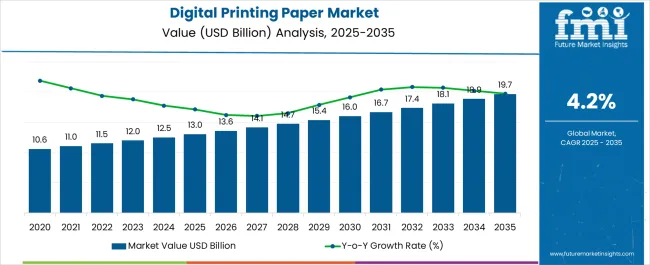
| Metric | Value |
|---|---|
| Digital Printing Paper Market Estimated Value in (2025 E) | USD 13.0 billion |
| Digital Printing Paper Market Forecast Value in (2035 F) | USD 19.7 billion |
| Forecast CAGR (2025 to 2035) | 4.2% |
The Digital Printing Paper market is expanding steadily, supported by the growing demand for high-quality and customizable printing solutions across commercial, industrial, and office applications. Increasing adoption of digital printing technologies, particularly in packaging, advertising, and publishing, has significantly boosted the consumption of specialized paper that ensures superior print clarity and color performance.
The shift from traditional offset printing to digital printing is further propelling market growth, as businesses seek cost efficiency, reduced turnaround time, and enhanced flexibility for short-run and on-demand printing. Growing emphasis on sustainable and recyclable materials in the paper industry is also shaping market dynamics, with manufacturers focusing on eco-friendly digital printing paper options to meet evolving regulatory and consumer expectations.
Advancements in coating technologies, surface finishing, and compatibility with diverse printing inks, including UV and water-based inks, are enhancing print performance, thereby supporting adoption As industries increasingly prioritize customization, quality, and sustainable solutions, the digital printing paper market is anticipated to register consistent growth in the coming years, driven by evolving applications and expanding end-use demand across both developed and emerging economies.
The digital printing paper market is segmented by gsm, material type, end user, printing technology, and geographic regions. By gsm, digital printing paper market is divided into 80 GSM – 200 GSM, 40 GSM – 80 GSM, 200 GSM – 400 GSM, and 400 GSM Or More. In terms of material type, digital printing paper market is classified into Pulp, Fibers, and Laminated Films. Based on end user, digital printing paper market is segmented into Printing Industry, Display Packaging Industry, and Photography And Business World. By printing technology, digital printing paper market is segmented into Inkjet Technology, Dry Toner Electrophotography, and Liquid Toner Electrophotography. Regionally, the digital printing paper industry is classified into North America, Latin America, Western Europe, Eastern Europe, Balkan & Baltic Countries, Russia & Belarus, Central Asia, East Asia, South Asia & Pacific, and the Middle East & Africa.
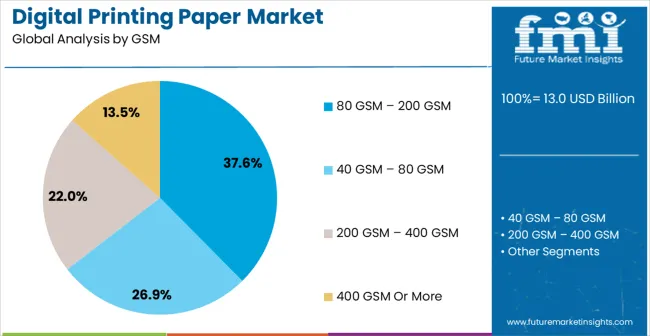
The 80 GSM – 200 GSM segment is projected to hold 37.6% of the Digital Printing Paper market revenue in 2025, making it the leading GSM category. This dominance is attributed to its versatility and widespread application across diverse printing requirements such as brochures, booklets, posters, and promotional materials. Papers within this GSM range offer an optimal balance between durability and flexibility, ensuring print clarity while remaining cost effective for large-scale production.
Their compatibility with both inkjet and laser printers enhances usability, allowing businesses to address high-volume as well as customized printing needs. Additionally, the ability to deliver vibrant colors and sharp text quality positions this GSM range as a preferred choice for advertising and marketing collateral.
Growing demand for high quality printing in education, publishing, and corporate sectors further supports its adoption The increasing use of digital printing for on-demand and short-run applications strengthens the relevance of this GSM range, ensuring its continued leadership in the market as industries prioritize performance and affordability.
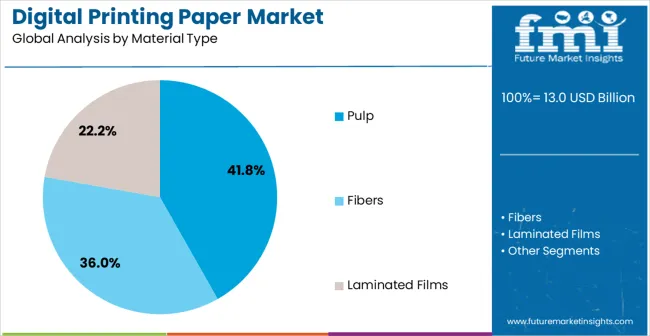
The pulp material type segment is expected to account for 41.8% of the Digital Printing Paper market revenue in 2025, establishing it as the dominant material category. The segment’s leadership is being reinforced by the abundant availability of pulp, cost efficiency, and strong adaptability to modern printing technologies. Pulp-based papers provide excellent ink absorption and print sharpness, making them suitable for high-resolution digital printing applications.
Sustainability initiatives and the rising focus on recyclable and biodegradable materials further strengthen the appeal of pulp-based paper, as industries align with eco-friendly practices. Continuous improvements in pulp processing and bleaching technologies have enhanced paper brightness, smoothness, and print consistency, driving widespread adoption across packaging, publishing, and office printing.
Their scalability and cost effectiveness allow pulp-based papers to cater to both bulk commercial demand and specialized printing projects As consumer preferences shift toward sustainable solutions and regulatory requirements on eco-compliance become more stringent, pulp-based digital printing paper is anticipated to remain the material of choice, reinforcing its dominant share in the market.
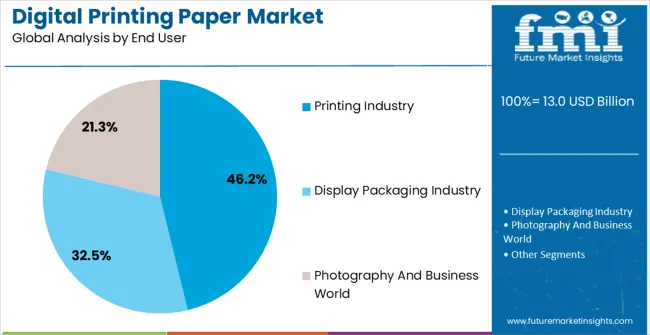
The printing industry segment is anticipated to hold 46.2% of the Digital Printing Paper market revenue in 2025, positioning it as the leading end-user industry. Growth is being driven by the increasing reliance on digital printing for producing marketing collateral, packaging inserts, catalogs, and publishing material with greater speed and customization. The printing industry benefits from digital printing paper’s enhanced print quality, flexibility in small batch production, and compatibility with a wide range of inks and printers.
This allows service providers to deliver short turnaround times while maintaining superior output quality, which is highly valued by corporate clients and advertisers. The trend of personalized printing, particularly in promotional campaigns and packaging, is further strengthening demand.
Sustainability initiatives within the printing industry are also encouraging the adoption of eco-friendly digital printing paper solutions As businesses and consumers continue to demand high-quality and customizable printed materials, the printing industry segment is expected to sustain its leadership, supported by continuous innovation in digital printing technologies and expanding commercial applications.
The digital printing is one of the popular types of printing. In digital printing a digital image or graphic content is directly sent to the digital printer for printing. The digital printing is done on a digital printing paper. The digital printing is of different types such as flexography, the need for digital printing have several advantage such as brilliant, color copies and best print results.
The digital printing paper is made of the pulp and wood. The digital printing paper may have coatings of the films for properly holding the colors for long time. Various types of papers are used in the digital printing process such as inkjet paper, laminated paper, non laminated paper, bleached paper, unbleached paper and butter paper.
The digital printing usually refers to the professional printing where small jobs from digital publishing and other digital source files are printed using the laser jet or inkjet printers. Inkjet papers are used by inkjet printer for printing. Glossy printing papers can be made by multicoating, resin coating, or cast coating on a laminated paper. Digital printing papers are used in various packaging industries that can be labels.
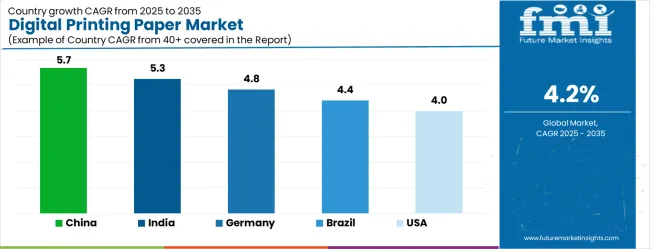
| Country | CAGR |
|---|---|
| China | 5.7% |
| India | 5.3% |
| Germany | 4.8% |
| Brazil | 4.4% |
| USA | 4.0% |
| UK | 3.6% |
| Japan | 3.2% |
The Digital Printing Paper Market is expected to register a CAGR of 4.2% during the forecast period, exhibiting varied country level momentum. China leads with the highest CAGR of 5.7%, followed by India at 5.3%. Developed markets such as Germany, France, and the UK continue to expand steadily, while the USA is likely to grow at consistent rates. Japan posts the lowest CAGR at 3.2%, yet still underscores a broadly positive trajectory for the global Digital Printing Paper Market. In 2024, Germany held a dominant revenue in the Western Europe market and is expected to grow with a CAGR of 4.8%. The USA Digital Printing Paper Market is estimated to be valued at USD 4.5 billion in 2025 and is anticipated to reach a valuation of USD 4.5 billion by 2035. Sales are projected to rise at a CAGR of 0.0% over the forecast period between 2025 and 2035. While Japan and South Korea markets are estimated to be valued at USD 640.2 million and USD 354.5 million respectively in 2025.
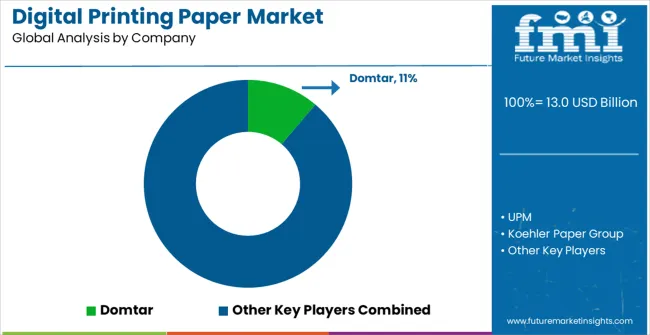
| Item | Value |
|---|---|
| Quantitative Units | USD 13.0 Billion |
| GSM | 80 GSM – 200 GSM, 40 GSM – 80 GSM, 200 GSM – 400 GSM, and 400 GSM Or More |
| Material Type | Pulp, Fibers, and Laminated Films |
| End User | Printing Industry, Display Packaging Industry, and Photography And Business World |
| Printing Technology | Inkjet Technology, Dry Toner Electrophotography, and Liquid Toner Electrophotography |
| Regions Covered | North America, Europe, Asia-Pacific, Latin America, Middle East & Africa |
| Country Covered | United States, Canada, Germany, France, United Kingdom, China, Japan, India, Brazil, South Africa |
| Key Companies Profiled | Domtar, UPM, Koehler Paper Group, International Paper, Nine Dragon Paper Holdings, WestRock, Stora Enso, Oji Paper Company, Kimberly-Clark, Smurfit Kappa, Nippon Paper, Sappi, BillerudKorsnäs, Mitsubishi HiTec Paper, Solenis, Antalis UK (Sequana SA), Clyde Paper & Print, Reich Paper, and Kelly Paper |
The global digital printing paper market is estimated to be valued at USD 13.0 billion in 2025.
The market size for the digital printing paper market is projected to reach USD 19.7 billion by 2035.
The digital printing paper market is expected to grow at a 4.2% CAGR between 2025 and 2035.
The key product types in digital printing paper market are 80 gsm – 200 gsm, 40 gsm – 80 gsm, 200 gsm – 400 gsm and 400 gsm or more.
In terms of material type, pulp segment to command 41.8% share in the digital printing paper market in 2025.






Our Research Products

The "Full Research Suite" delivers actionable market intel, deep dives on markets or technologies, so clients act faster, cut risk, and unlock growth.

The Leaderboard benchmarks and ranks top vendors, classifying them as Established Leaders, Leading Challengers, or Disruptors & Challengers.

Locates where complements amplify value and substitutes erode it, forecasting net impact by horizon

We deliver granular, decision-grade intel: market sizing, 5-year forecasts, pricing, adoption, usage, revenue, and operational KPIs—plus competitor tracking, regulation, and value chains—across 60 countries broadly.

Spot the shifts before they hit your P&L. We track inflection points, adoption curves, pricing moves, and ecosystem plays to show where demand is heading, why it is changing, and what to do next across high-growth markets and disruptive tech

Real-time reads of user behavior. We track shifting priorities, perceptions of today’s and next-gen services, and provider experience, then pace how fast tech moves from trial to adoption, blending buyer, consumer, and channel inputs with social signals (#WhySwitch, #UX).

Partner with our analyst team to build a custom report designed around your business priorities. From analysing market trends to assessing competitors or crafting bespoke datasets, we tailor insights to your needs.
Supplier Intelligence
Discovery & Profiling
Capacity & Footprint
Performance & Risk
Compliance & Governance
Commercial Readiness
Who Supplies Whom
Scorecards & Shortlists
Playbooks & Docs
Category Intelligence
Definition & Scope
Demand & Use Cases
Cost Drivers
Market Structure
Supply Chain Map
Trade & Policy
Operating Norms
Deliverables
Buyer Intelligence
Account Basics
Spend & Scope
Procurement Model
Vendor Requirements
Terms & Policies
Entry Strategy
Pain Points & Triggers
Outputs
Pricing Analysis
Benchmarks
Trends
Should-Cost
Indexation
Landed Cost
Commercial Terms
Deliverables
Brand Analysis
Positioning & Value Prop
Share & Presence
Customer Evidence
Go-to-Market
Digital & Reputation
Compliance & Trust
KPIs & Gaps
Outputs
Full Research Suite comprises of:
Market outlook & trends analysis
Interviews & case studies
Strategic recommendations
Vendor profiles & capabilities analysis
5-year forecasts
8 regions and 60+ country-level data splits
Market segment data splits
12 months of continuous data updates
DELIVERED AS:
PDF EXCEL ONLINE
Digital Hall Effect Gaussmeter Market Size and Share Forecast Outlook 2025 to 2035
Digital Group Dining Service Market Size and Share Forecast Outlook 2025 to 2035
Digital Pathology Displays Market Size and Share Forecast Outlook 2025 to 2035
Digital Rights Management Market Size and Share Forecast Outlook 2025 to 2035
Digital Liquid Filling Systems Market Size and Share Forecast Outlook 2025 to 2035
Digital Transformation Industry Analysis in MENA Size and Share Forecast Outlook 2025 to 2035
Digital X-Ray Equipment Market Size and Share Forecast Outlook 2025 to 2035
Digital Marketing Analytics Industry Analysis in Latin America Forecast Outlook 2025 to 2035
Digital Health Market Forecast and Outlook 2025 to 2035
Digital Pen Market Forecast and Outlook 2025 to 2035
Digital X-ray Market Size and Share Forecast Outlook 2025 to 2035
Digital Elevation Model Market Size and Share Forecast Outlook 2025 to 2035
Digital Pump Controller Market Size and Share Forecast Outlook 2025 to 2035
Digital Battlefield Market Size and Share Forecast Outlook 2025 to 2035
Digital Product Passport Software Market Size and Share Forecast Outlook 2025 to 2035
Digital Lending Platform Market Size and Share Forecast Outlook 2025 to 2035
Digital Shipyard Market Size and Share Forecast Outlook 2025 to 2035
Digital Freight Matching Market Size and Share Forecast Outlook 2025 to 2035
Digital Textile Printer Market Size and Share Forecast Outlook 2025 to 2035
Digital Thermo Anemometer Market Size and Share Forecast Outlook 2025 to 2035

Thank you!
You will receive an email from our Business Development Manager. Please be sure to check your SPAM/JUNK folder too.
Chat With
MaRIA